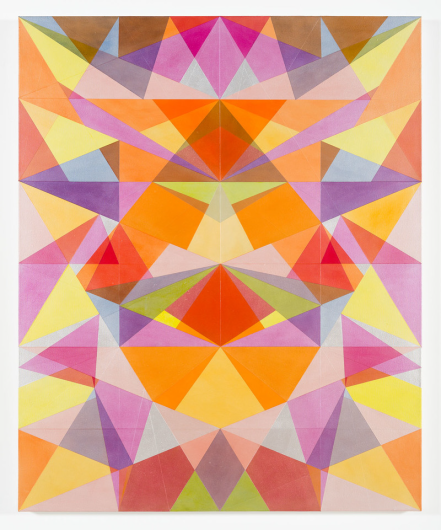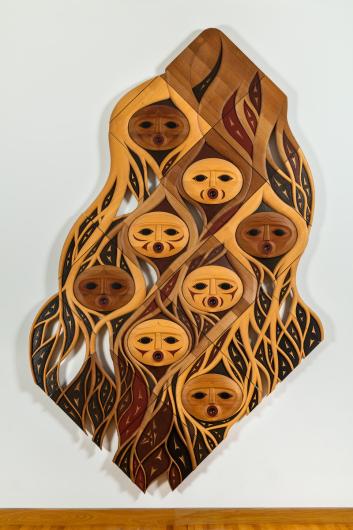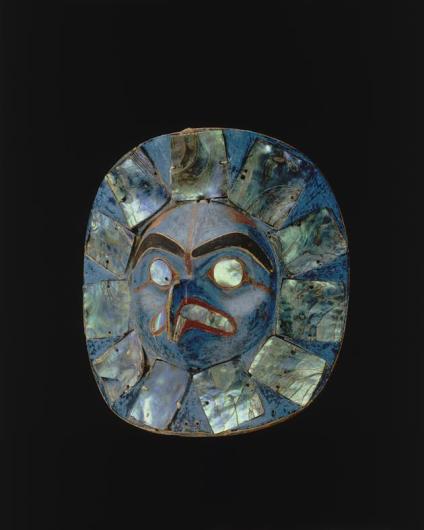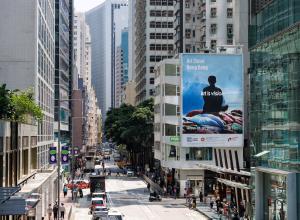
Between Rabbit and Fox, 2017, Jeffrey Gibson, Native American, Mississippi Band of Choctaw Indians/Cherokee, born 1972, acrylic and graphite on canvas, 70 x 50 1/8 in., Purchased with funds from the Contemporary Collectors Forum and General Acquisition Fund, 2019.30.
Native American Heritage Month is a time when people often seek to know and experience more about Indigenous art and culture. The Seattle Art Museum (SAM) is an excellent resource. The main galleries devoted to Native art were reinstalled in 2014—as Art and Life Along the Northwest Coast—with historical and contemporary works in dialogue; that ethos has since flowed into the more recent reinstallations in the American and modern and contemporary galleries. Works by contemporary artists are displayed with older historic pieces, creating a visual dialogue that continues throughout the museum, with works grouped by genre and topic as well as ethnographic considerations.
This gives a sense of cultural continuity and showcases the vitality of Indigenous arts and crafts—the very real living tradition of artistic creation in the Native community—while placing it firmly within the greater realm of worldwide arts and culture movements. These pieces were not created in a vacuum, and the artists were informed and influenced by worldwide trends as well as long standing traditions.
SAM respectfully acknowledges being on Indigenous land, in the traditional territories of the Coast Salish people. Its collection honors the ongoing connection to these communities now, in the past, and in the future. Here are ten pieces deemed “must see” by museum staff, curators and visitors.

An iconic version of an epic myth, this Tlingit hat, Lkaayaak Yeil S’aaxw or Box of Daylight Raven Hat, ca. 1850, shows Raven holding the box that had imprisoned the sun, the moon and the stars, inlaid with mirror and abalone shell, and accented with red paint.
Image: Lkaayaak yeil s'aaxw (Box of Daylight Raven Hat), ca. 1850, Native American, Tlingit, Taku, maple, mirror, abalone shell, bird skin, paint, sea lion whiskers, copper, leather, Flicker feathers, 11 7/8 x 7 3/4 x 12 1/4 in. (30.2 x 19.7 x 31.1 cm), Gift of John H. Hauberg.

The brightly colored acrylic and graphite painting, Between Rabbit and Fox, by Choctaw/Cherokee artist Jeffrey Gibson (1972), is a study in triangular geometric forms, arranged in patterns informed by the traditional North Coast Art Style. The painting merges the strong shapes of formline art with a modernist sensibility and a contemporary color palette.
Image: Between Rabbit and Fox, 2017, Jeffrey Gibson, Native American, Mississippi Band of Choctaw Indians/Cherokee, born 1972, acrylic and graphite on canvas, 70 x 50 1/8 in. Purchased with funds from the Contemporary Collectors Forum and General Acquisition Fund.

A dramatic, vividly colored bird with an enormous circular beak, Crooked Beak Mask, or Galukw'amhl, ca. 1940, by Willie Seaweed (1873 - 1967), was originally part of a set of hamatsa masks–used in the tseyka, or red cedar bark ceremony. Created while tseyka dances were banned by the Canadian government, the mask is testament to the enduring power of art as resistance. Contemporary Kwakwaka'wakw artists still make and use similar masks.
Image: Galukw'amhl (Mask of the Crooked Beak), ca. 1940, Willie Seaweed (Hilamas), Kwakwaka’wakw, ‘Nak’waxda’xw, Blunden Harbour, 1873-1967, red cedar, paint, red cedar bark, mahogany plywood, leather, cord, 33 7/8 x 11 x 9 1/2 in. (86 x 27.9 x 24.1 cm), Gift of John H. Hauberg.

A recent acquisition now on view in the entrance to the American art galleries, Architecture of Return, Escape, by Tlingit/Unangax̂ artist Nicholas Galanin (1979) is a modern hide painting cleverly interrogating colonialism while offering a visual exit plan. The blue-pigmented deer hide showcases the floor plan of the British Museum, with pictographs referencing contested Indigenous objects in its collection, while a red line maps an escape route.
Image: Architecture of return, escape (The British Museum), 2022, Nicholas Galanin, Native American (Tlingit/Unangax), born 1979, pigment and acrylic on deer hide, 36 x 55 in. (91.4 x 139.7 cm), General Acquisition Fund, 2022.33 © Nicholas Galanin.

An impressive Tlingit painted wooden screen, adorned with sacred mythological beings, Yéil X’eenh or Raven Screen, ca. 1810, is composed of multiple black, white and red ovoid shapes—some containing smaller figures. The large figure of Raven, the heroic trickster god, crouches in a protective stance–delineated by black form-lines.
Yéil X'eenh (Raven Screen), ca. 1810, attributed to Native American Kadyisdu.axch', Tlingit, Kiks.adi clan, Gaanaxteidi', Tlingit, Klukwan (Tlákw.aan), Frog House, spruce, paint, 105 3/4 x 129 in. (268.62 x 327.66 cm), Gift of John H. Hauberg.

A visitor favorite, the installation piece Blanket Stories: Three Sisters, Four Pelts, Sky Woman, Cousin Rose, and All My Relations by Marie Watt (1967), uses a column of folded wool blankets—in a variety of colors—to explore the stories and memories that blankets carry. The texture of the blankets evokes feelings of warmth, comfort and protection, while their structure is reminiscent of architectural forms, memorials, totem poles and towering trees—adding layers of nuance to the viewing experience.
Image: Blanket Stories: Three Sisters, Four Pelts, Sky Woman, Cousin Rose, and All My Relations, 2007, Marie Watt, American, born 1967, wool blankets, satin binding, with salvaged industrial yellow cedar timber base, 150 x 40 x 40 in. (381 x 101.6 x 101.6 cm), General Acquisition Fund, in honor of the 75th Anniversary of the Seattle Art Museum, 2007.41 © Marie Watt.

Intricately carved in fine relief by Haida artist Charles Edenshaw—da.a xiigang (1839–1920), this black shale argillite Platter, Qwa.a. Qiihlaa, ca. 1885, depicts Raven and the Fungus Man in an ornate canoe. A traditional Haida art form for over two hundred years, carved argillite was one of the first tourist art commodities on the Northwest coast.
Image: Platter (qwa.a. qiihlaa), ca. 1885, Charles Edenshaw, First Nations, Haida, 1839 – 1920, argillite, 2 1/4 x 12 15/16 in. (5.7 x 32.9 cm), Gift of John H. Hauberg.

A stunning wall carving in red and yellow cedar, The First People, by Musqueam artist Susan Point (1951) depicts eight abstract human faces looking out from a network of roots and waterways. This piece celebrates the First Peoples’ harmonious connection to their environment.
Image: The First People, 2008, Susan Point, Musqueam, Canadian, born 1951, red and yellow cedar, 144 x 89 in. (365.8 x 266.1 cm), Margaret E. Fuller Purchase Fund, in honor of the 75th Anniversary of the Seattle Art Museum, 2008.31 © Susan Point. Photo: Nathaniel Willson

Currently part of the special exhibition American Art: The Stories We Carry, Aam'halait (Headdress Frontlet), ca. 1860, was probably created by a Tsimshian artist for a chief. Now a treasured family artifact, the ceremonial sky blue wooden headdress depicts a bird with a curved beak and bright eyes, inlaid with abalone shells.
Image: Aam'halait (headdress frontlet), ca. 1860, Tsimshian, maple wood, abalone shell, paint, 9 3/8 x 9 x 3 in. (23.81 x 22.86 x 7.62 cm), Gift of John H. Hauberg.

A multimedia portrait depicting Seattle-area Indigenous women and children posed against the city skyline, with Yoshida Hiroshi’s (1876‒1950) woodblock print of Mount Tahoma (Rainier) in the background, Áakiiwilaxpaake (People of the Earth), by Apsáalooke/Crow artist Wendy Red Star (1981), powerfully reinserts Native people into the American art canon. This piece was a commission for American Art: The Stories We Carry that SAM later acquired for the collection.
Image: Áakiiwilaxpaake (People of the Earth), 2022, Wendy Red Star, Native American, Apsáalooke/Crow, born 1981, archival inkjet prints, Dibond, LED lights, electrical components, wood, milk plexiglass, 84 x 62 x 12 in. (213.4 x 157.5 x 30.5 cm), Bruce Leven Acquisition Fund, 2022.44. Portrait Photography: Native Light Photography Seattle, CC BY-SA 2.0, via Wikimedia Commons, Tree Line Photography: kamchatka (Galyna Andrusko), Printing: Pushdot Studios, Design: Corson Androski and Ditroën Inc.

An iconic version of an epic myth, this Tlingit hat, Lkaayaak Yeil S’aaxw or Box of Daylight Raven Hat, ca. 1850, shows Raven holding the box that had imprisoned the sun, the moon and the stars, inlaid with mirror and abalone shell, and accented with red paint.
Image: Lkaayaak yeil s'aaxw (Box of Daylight Raven Hat), ca. 1850, Native American, Tlingit, Taku, maple, mirror, abalone shell, bird skin, paint, sea lion whiskers, copper, leather, Flicker feathers, 11 7/8 x 7 3/4 x 12 1/4 in. (30.2 x 19.7 x 31.1 cm), Gift of John H. Hauberg.

The brightly colored acrylic and graphite painting, Between Rabbit and Fox, by Choctaw/Cherokee artist Jeffrey Gibson (1972), is a study in triangular geometric forms, arranged in patterns informed by the traditional North Coast Art Style. The painting merges the strong shapes of formline art with a modernist sensibility and a contemporary color palette.
Image: Between Rabbit and Fox, 2017, Jeffrey Gibson, Native American, Mississippi Band of Choctaw Indians/Cherokee, born 1972, acrylic and graphite on canvas, 70 x 50 1/8 in. Purchased with funds from the Contemporary Collectors Forum and General Acquisition Fund.
Megan D Robinson
Megan D Robinson writes for Art & Object and the Iowa Source.























